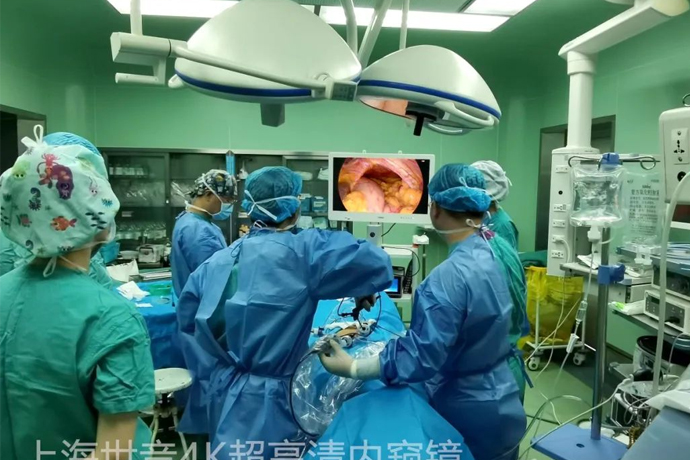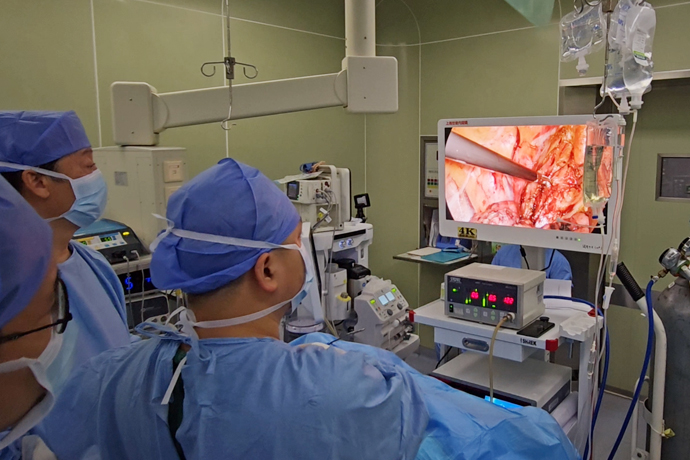[General Surgery Laparoscopy] 4K ultra-high definition laparoscopic hiatal hernia repair
Release time: 09 Jul 2024 Author:Shrek
Hiatal surgery
It refers to the phenomenon that abdominal organs and tissues other than the esophagus enter the chest cavity through the enlarged esophageal hiatus. A hernia with a smaller hiatus will not cause any symptoms, but a hernia with a larger hiatus will cause symptoms such as heartburn, acid reflux, difficulty swallowing, chest or upper abdominal pain, and chronic iron deficiency anemia.

Pathogenesis: The incidence of hiatal hernia can be divided into congenital and acquired. The congenital type is caused by the underdevelopment of the diaphragmatic esophageal hiatus, which is wider and looser than normal. Acquired syndrome may be due to the following reasons. First, the esophageal hiatus appears around the esophageal hiatus with age. The supporting tissue relaxation and long-term chronic diseases weaken the diaphragm muscle tension, causing the esophageal hiatus to expand. Second, increased intra-abdominal pressure, such as obesity, ascites, pregnancy, constipation, etc. Third, it can be secondary to long-term reflux esophagitis, which is caused by shortening and inflammation of the esophagus due to fibrosis, causing secondary esophageal spasm and causing part of the gastric pouch to be pulled toward the chest cavity. Fourth, hiatal hernia after surgery, scarring of the esophagus after surgery, fibrosis caused by esophagitis and excessive vagus nerve excitement, will cause the esophagus to shorten and pull the abdominal organs upward, thus leading to the occurrence of hiatal hernia.
Epidemiology: Hiatal hernia is one of the common digestive system diseases. Its incidence continues to increase with age, accounting for 10% of patients under 40 years old and 70% of patients over 70 years old. This disease is more common in women, obesity, and people over 50 years old (hiatal hernia patient age proportion chart). People who meet this characteristic must pay attention!
Classification:
Type I hernia: The most common, accounting for about 85%. It means that the gastroesophageal junction moves up above the diaphragm and is higher than the fundus of the stomach, and the stomach still maintains its normal shape.
Type II hernia: is a typical paraesophageal hernia. It means that the gastroesophageal junction is in a normal position, but part of the stomach fundus enters the chest cavity through the hiatus.
Type III hernia: a mixed type of type I and type II hernia, accounting for 90% of paraesophageal hernias. Refers to the entry of the gastroesophageal junction and the fundus of the stomach into the chest cavity through the hiatus.
Type IV hernia: In addition to the stomach, other organs in the abdominal cavity such as the greater omentum, colon or small intestine also enter the chest cavity through the hiatus.
The surgical method of hiatal hernia repair is suitable for the following situations:
1. Those whose symptoms are severe and persistent and medical treatment is ineffective.
2. Patients with severe reflux esophagitis.
3. Those with bleeding or suspected malignant transformation.
Preparation before surgery
1. Control respiratory infections.
2. Treat reflux esophagitis.
3. Correct the nutritional status of the whole body.
Position selection and anesthesia methods
Choice of surgical position
Choose the right side sleeping position.
Anesthesia method
General anesthesia with endotracheal intubation.
Laparoscopic hiatal hernia repair - operating techniques
Step One: Right Side of Esophagus
Step 2: Above the esophagus
Step 3: Lower and left side of esophagus
Step 4: Left diaphragmatic angle
The summary is: right up, down, left, left, very easy to remember.
Transabdominal repair of hiatal hernia
1. Make an incision in the middle of the upper abdomen and enter the abdominal cavity.
2. Pull the stomach downward and cut transversely the peritoneal reflux in front of the lower end of the esophagus.
3. Blunt separation of the diaphragmatic esophageal ligament.
4. Use gauze to pull the esophagus upward to the left.
5. Suture the inner and outer edges of the diaphragmatic crus behind the esophagus with 3 to 4 interrupted stitches from bottom to top.
6. Carefully test whether the tightness of the esophageal hiatus after suturing is appropriate. The standard is the same as that of "transthoracic repair".
7. Suture the lower esophagus and the diaphragmatic esophageal ligament intermittently, and fix it with the esophageal hiatus.
8. Suture the abdominal incision layer by layer.
Daily maintenance
Precautions for daily life of patients with hiatal hernia
Adjust your posture
You can take a walk after a meal. Do not sit on a low chair. After lunch, you can read a newspaper or take a nap on a recliner. It is forbidden to bend over or squat after a meal. At night, you should raise your upper body by about 20 degrees and support your buttocks with something. To prevent the body from sliding down after a deep sleep, you can also use a hand-cranked or electric bed.
Make good bowel movements
Be sure to pay attention to your bowel movements. It is very important to maintain daily bowel movements. It is not advisable to defecate once every 2 to 3 days. In addition, obesity, lifting heavy objects, waist restraints, smoking, etc. are also factors that induce hiatal hernia reflux. You should try your best to avoid.
Dietary considerations for patients with hiatal hernia
Chew slowly
Food intake should be controlled, and you should eat slowly. You should not be full after three meals. If you feel hungry, you can eat a small snack about 2 hours after the meal. Three meals a day should be basically scheduled, and you should not overeat.
Avoid spicy food
You should choose good varieties. You should eat as little food as possible that is too sweet, too oily, or too spicy. You should control yourself and act according to your ability. The criterion is that no symptoms will occur after eating. You should also drink less porridge, because it can easily cause gastric bloating and Acid reflux.
Avoid drinking gas-filled drinks
Drinking alcohol and gaseous beverages are all factors that induce hiatal hernia reflux and should be avoided as much as possible.

- Recommended news
- 【General Surgery Laparoscopy】Cholecystectomy
- Surgery Steps of Hysteroscopy for Intrauterine Adhesion
- 【4K Basics】4K Ultra HD Endoscope Camera System
- 【General Surgery Laparoscopy】"Two-step stratified method" operation flow of left lateral hepatic lobectomy
- 【General Surgery Laparoscopy】Left Hepatectomy